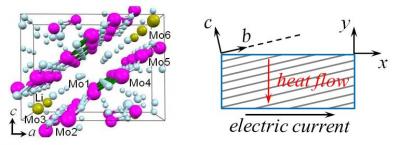New insight into thermoelectric materials may boost green technologies

Lithium purple-bronze (LiPB) is a thermoelectric material comprised of aligned conducting, zig-zag chains of molybdenum and oxygen (left image, pink and white circles with green bonds). When an electric current was applied in a direction slightly misaligned with the chains (depicted as gray lines, right image), heat flowed perpendicular to the current, a phenomenon known as the transverse Peltier effect. The efficiency of this effect in LiPB was among the largest known for a single compound. Credit: Dr. Joshua Cohn, University of Miami
Thermoelectric materials can turn a temperature difference into an electric voltage. Among their uses in a variety of specialized applications: generating power on space probes and cooling seats in fancy cars.
University of Miami (UM) physicist Joshua Cohn and his collaborators report new surprising properties of a metal named lithium purple-bronze (LiPB) that may impact the search for materials useful in power generation, refrigeration, or energy detection. The findings are published in the journal Physical Review Letters.
“If current efficiencies of thermoelectric materials were doubled, thermoelectric coolers might replace the conventional gas refrigerators in your home,” said Cohn, professor and chairman of the UM Department of Physics in the College of Arts and Sciences and lead author of the study. “Converting waste heat into electric power, for example, using vehicle exhaust, is a near-term 'green' application of such materials.”
Useful thermoelectric materials produce a large voltage for a given temperature difference, with the ratio known as “thermopower.” LiPB is comprised of aligned conducting chains. The researchers found that this material has very different thermopowers when the temperature difference is applied parallel or perpendicular to the conducting chains.
When an electric current was applied in a direction slightly misaligned with the chains, heat flowed perpendicular to the current, a phenomenon known as the “transverse Peltier effect.” The efficiency of this effect in LiPB was among the largest known for a single compound.
“That such a large directional difference in thermopower exists in a single compound is exceedingly rare and makes applications possible,” Cohn said. “This is significant because transverse Peltier devices typically employ a sandwich of different compounds that is more complicated and costly to fabricate.”
As their motivation for the work, Cohn noted that metals with a similar electronic structure often exhibit interesting physics and the thermoelectric properties of LiPB had never been studied in detail. “The present material,” he said, “might be useful as it is, but the larger implication of our work is that the ingredients underlying its special properties may serve as a guide to finding or engineering new and improved materials.”
The study is titled “Extreme Thermopower Anisotropy and Interchain Transport in the Quasi-One-Dimensional Metal Li0.9Mo6O17” Other authors of the study are Saeed Moshfeghyeganeh,Ph.D. student in the Department of Physics at UM; Carlos A. M. dos Santos, professor at the Escola de Engenharia de Lorena in Brazil and John J. Neumeier, professor in the Department of Physics, Montana State University.
Media Contact
More Information:
http://www.miami.edu/All latest news from the category: Materials Sciences
Materials management deals with the research, development, manufacturing and processing of raw and industrial materials. Key aspects here are biological and medical issues, which play an increasingly important role in this field.
innovations-report offers in-depth articles related to the development and application of materials and the structure and properties of new materials.
Newest articles

Silicon Carbide Innovation Alliance to drive industrial-scale semiconductor work
Known for its ability to withstand extreme environments and high voltages, silicon carbide (SiC) is a semiconducting material made up of silicon and carbon atoms arranged into crystals that is…

New SPECT/CT technique shows impressive biomarker identification
…offers increased access for prostate cancer patients. A novel SPECT/CT acquisition method can accurately detect radiopharmaceutical biodistribution in a convenient manner for prostate cancer patients, opening the door for more…

How 3D printers can give robots a soft touch
Soft skin coverings and touch sensors have emerged as a promising feature for robots that are both safer and more intuitive for human interaction, but they are expensive and difficult…





















